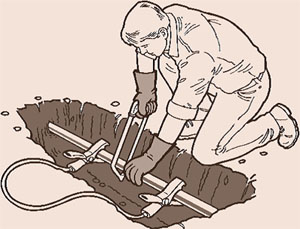When engaged in tasks involving metal water services, there exists a significant risk of severe or fatal electric shock for workers. Acquire the knowledge to effectively mitigate electrical safety risks associated with working on metal water services and fulfill both legal and safety obligations.
This guidance is particularly pertinent for plumbers and individuals involved in activities related to metallic water services.
Understanding the term 'working on metal water services' The phrase 'working on metal water services' encompasses actions such as removing water meters or cutting through/disconnecting metallic water pipes.
Identifying the risks associated with working on metal water services The primary electrical hazard involves the potential for severe or fatal electric shock during activities involving metallic water pipes.
For safe electricity discharge under fault conditions, metallic water pipes must be 'earthed.' In the event of an electrical fault, the piping can become 'live,' allowing electrical current to flow along the water pipe.
Workers are exposed to the risk of a fatal electric shock when cutting through a water pipe, removing a water meter, or disconnecting the main earth wire from the water pipe. In some instances, mere contact with the water pipe can result in an electric shock.
Effectively managing the risk Workers and management collaboration is crucial to minimizing these risks, fostering a safe work environment that benefits everyone. Explore more insights on creating a secure workplace.
Adhering to safe practices when working on metal water services Implementing a tailored safe system of work is essential, incorporating specific procedures. Additionally, reference AS/NZS 3500.1 Plumbing and drainage – Part 1: Water services for comprehensive guidance.
Plan
- Plan the job by assessing electrical and other risks. Take appropriate steps to stay safe.
Do
- Before starting work, ask if anyone has experienced shocks or tingles from the taps or other metalwork within the installation. If yes, cancel the job and notify the electricity network owner/distributor, as this could indicate a potentially dangerous situation (fault).
- Where possible, switch off the electrical main switch or switches (including the hot water main switch) at the premises. Attach a tag reading DANGER DO NOT SWITCH ON.
- Take extra steps to reduce electrical risk. Avoid skin contact with the metallic water pipes you’re working on. Wear gloves and long trousers. Consider using rubber ground mats, especially where work involves kneeling or lying on the ground.
- Thoroughly clean a section of metal pipe on each side of the length you’re repairing.
- Ensure the insulated bridging conductor (including its connections) is in good condition before use.
- Attach an insulated bridging conductor to span the length of the pipe you’re cutting (Fig. 1). A bridging conductor is a stranded copper cable that can carry 70 amperes. It should have appropriate end clamps and insulated handgrips.

Fig 1: Attach an insulated bridge conductor to span the length of the pipe to be cut
- Check that the clamps make good electrical contact with the metal pipe.
- Check that the bridging conductor remains in place until you finish the work.
- If you’re replacing an existing metallic service pipe with a non-metallic pipe or fittings, have the electrical installation checked by a licensed electrical contractor. If necessary, have them modify it to ensure the electrical earthing system stays effective.
Act
- Notify the local electricity distributor and the householder immediately if you see anything abnormal (such as electric sparks) or if you feel an electric shock.
For workers
As a worker, you are responsible under the Work Health and Safety Act 2011 to take reasonable care for your own electrical safety and others who may be affected by what you do or don’t do.
Follow health and safety instructions from your employer, use equipment properly, follow safe work policies and procedures, and attend training.
If something is unclear, or you are uncertain, ask for an explanation. Raise health and safety concerns and report hazards and work-related injury or illness.
